2018 KIA K900 oil
[x] Cancel search: oilPage 506 of 544
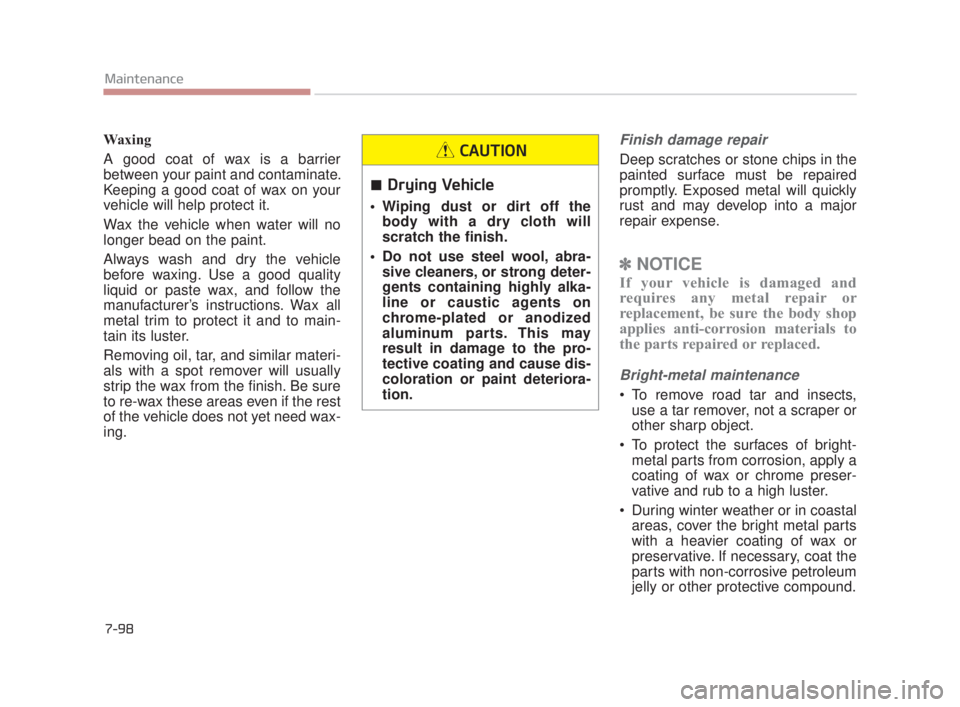
Waxing
A good coat of wax is a barrier
between your paint and contaminate.
Keeping a good coat of wax on your
vehicle will help protect it.
Wax the vehicle when water will no
longer bead on the paint.
Always wash and dry the vehicle
before waxing. Use a good quality
liquid or paste wax, and follow the
manufacturer’s instructions. Wax all
metal trim to protect it and to main-
tain its luster.
Removing oil, tar, and similar materi-
als with a spot remover will usually
strip the wax from the finish. Be sure
to re-wax these areas even if the rest
of the vehicle does not yet need wax-
ing. Finish damage repair
Deep scratches or stone chips in the
painted surface must be repaired
promptly. Exposed metal will quickly
rust and may develop into a major
repair expense.
✽NOTICE
If your vehicle is damaged and
requires any metal repair or
replacement, be sure the body shop
applies anti-corrosion materials to
the parts repaired or replaced.
Bright-metal maintenance
To remove road tar and insects,
use a tar remover, not a scraper or
other sharp object.
To protect the surfaces of bright- metal parts from corrosion, apply a
coating of wax or chrome preser-
vative and rub to a high luster.
During winter weather or in coastal areas, cover the bright metal parts
with a heavier coating of wax or
preservative. If necessary, coat the
parts with non-corrosive petroleum
jelly or other protective compound.
Drying Vehicle
Wiping dust or dirt off thebody with a dry cloth will
scratch the finish.
Do not use steel wool, abra- sive cleaners, or strong deter-
gents containing highly alka-
line or caustic agents on
chrome-plated or anodized
aluminum parts. This may
result in damage to the pro-
tective coating and cause dis-
coloration or paint deteriora-
tion.
CAUTION
7-98
Maintenance
KH USA 7:2018 4/14/2017 6:41 PM Page 98
Page 510 of 544
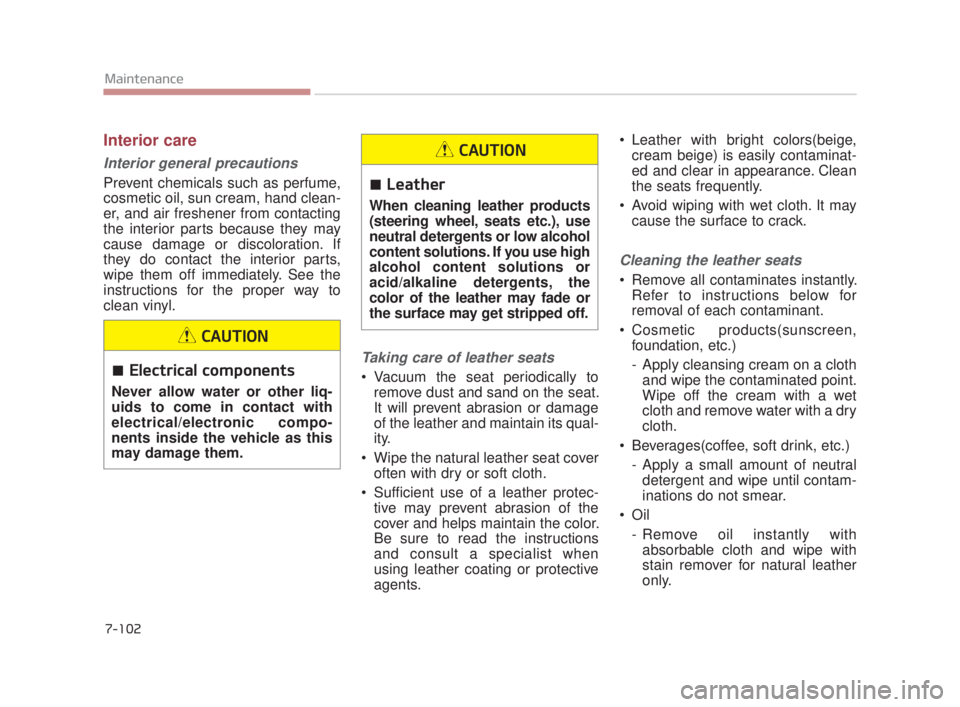
7-102
Maintenance
Interior care
Interior general precautions
Prevent chemicals such as perfume,
cosmetic oil, sun cream, hand clean-
er, and air freshener from contacting
the interior parts because they may
cause damage or discoloration. If
they do contact the interior parts,
wipe them off immediately. See the
instructions for the proper way to
clean vinyl.
Taking care of leather seats
Vacuum the seat periodically toremove dust and sand on the seat.
It will prevent abrasion or damage
of the leather and maintain its qual-
ity.
Wipe the natural leather seat cover often with dry or soft cloth.
Sufficient use of a leather protec- tive may prevent abrasion of the
cover and helps maintain the color.
Be sure to read the instructions
and consult a specialist when
using leather coating or protective
agents. Leather with bright colors(beige,
cream beige) is easily contaminat-
ed and clear in appearance. Clean
the seats frequently.
Avoid wiping with wet cloth. It may cause the surface to crack.
Cleaning the leather seats
Remove all contaminates instantly.Refer to instructions below for
removal of each contaminant.
Cosmetic products(sunscreen, foundation, etc.)
- Apply cleansing cream on a clothand wipe the contaminated point.
Wipe off the cream with a wet
cloth and remove water with a dry
cloth.
Beverages(coffee, soft drink, etc.) - Apply a small amount of neutraldetergent and wipe until contam-
inations do not smear.
- Remove oil instantly withabsorbable cloth and wipe with
stain remover for natural leather
only.
Electrical components
Never allow water or other liq-
uids to come in contact with
electrical/electronic compo-
nents inside the vehicle as this
may damage them.
CAUTION
Leather
When cleaning leather products
(steering wheel, seats etc.), use
neutral detergents or low alcohol
content solutions. If you use high
alcohol content solutions or
acid/alkaline detergents, the
color of the leather may fade or
the surface may get stripped off.
CAUTION
KH USA 7:2018 4/14/2017 6:41 PM Page 102
Page 511 of 544
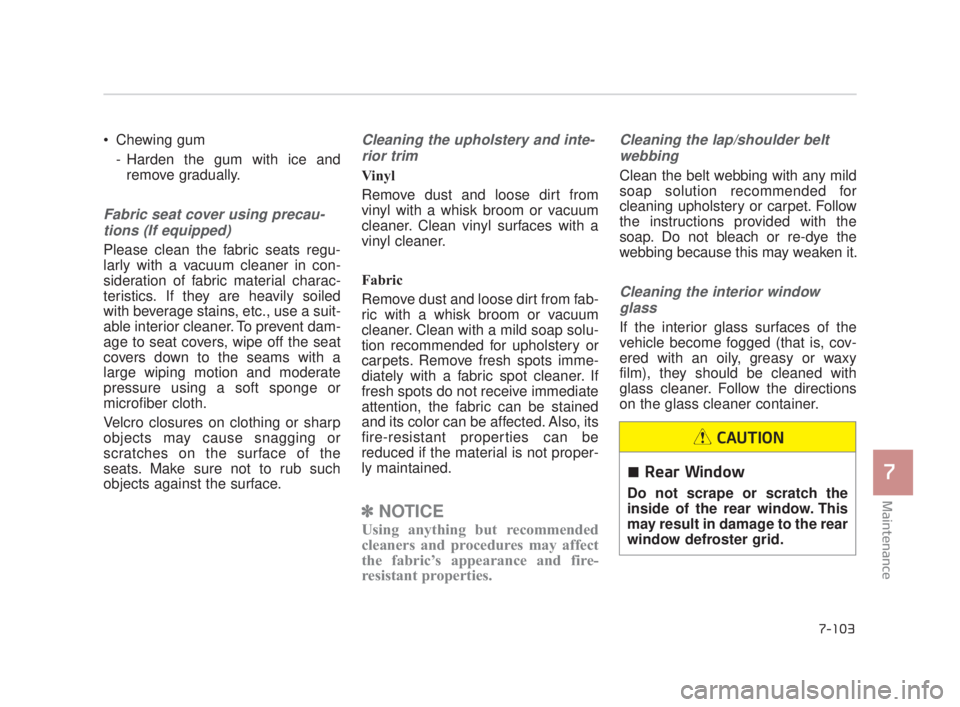
Maintenance
7
7-103
Chewing gum - Harden the gum with ice andremove gradually.
Fabric seat cover using precau-
tions (If equipped)
Please clean the fabric seats regu-
larly with a vacuum cleaner in con-
sideration of fabric material charac-
teristics. If they are heavily soiled
with beverage stains, etc., use a suit-
able interior cleaner. To prevent dam-
age to seat covers, wipe off the seat
covers down to the seams with a
large wiping motion and moderate
pressure using a soft sponge or
microfiber cloth.
Velcro closures on clothing or sharp
objects may cause snagging or
scratches on the surface of the
seats. Make sure not to rub such
objects against the surface.
Cleaning the upholstery and inte-rior trim
Vinyl
Remove dust and loose dirt from
vinyl with a whisk broom or vacuum
cleaner. Clean vinyl surfaces with a
vinyl cleaner.
Fabric
Remove dust and loose dirt from fab-
ric with a whisk broom or vacuum
cleaner. Clean with a mild soap solu-
tion recommended for upholstery or
carpets. Remove fresh spots imme-
diately with a fabric spot cleaner. If
fresh spots do not receive immediate
attention, the fabric can be stained
and its color can be affected. Also, its
fire-resistant properties can be
reduced if the material is not proper-
ly maintained.
✽ NOTICE
Using anything but recommended
cleaners and procedures may affect
the fabric’s appearance and fire-
resistant properties.
Cleaning the lap/shoulder belt
webbing
Clean the belt webbing with any mild
soap solution recommended for
cleaning upholstery or carpet. Follow
the instructions provided with the
soap. Do not bleach or re-dye the
webbing because this may weaken it.
Cleaning the interior windowglass
If the interior glass surfaces of the
vehicle become fogged (that is, cov-
ered with an oily, greasy or waxy
film), they should be cleaned with
glass cleaner. Follow the directions
on the glass cleaner container.
Rear Window
Do not scrape or scratch the
inside of the rear window. This
may result in damage to the rear
window defroster grid.
CAUTION
KH USA 7:2018 4/14/2017 6:41 PM Page 103
Page 522 of 544
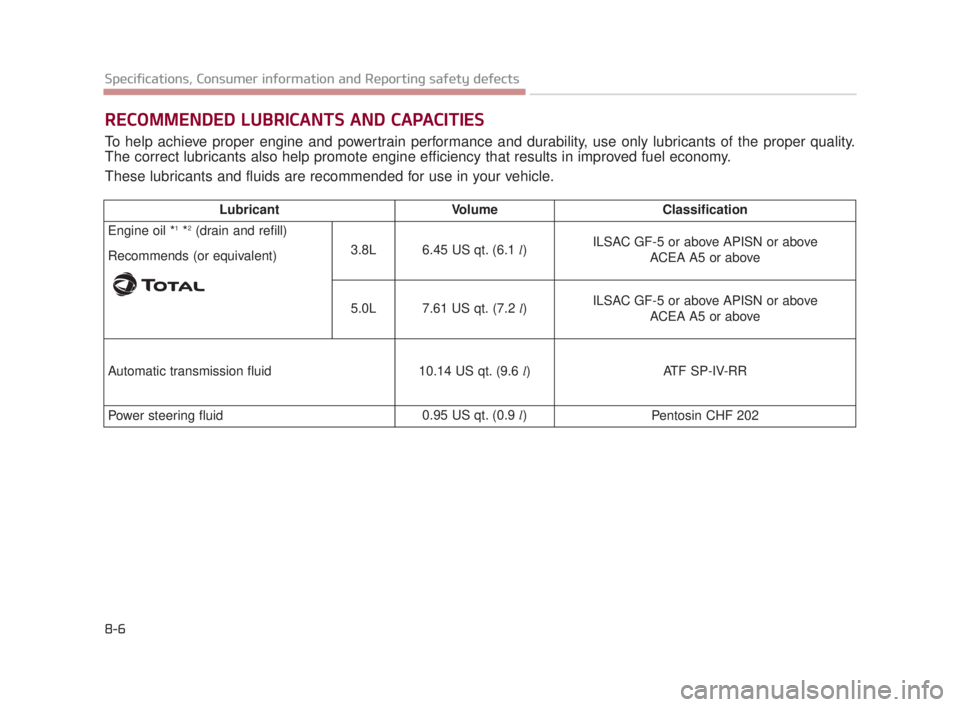
8-6
Specifications, Consumer information and Reporting safety defects
RECOMMENDED LUBRICANTS AND CAPACITIES
To help achieve proper engine and powertrain performance and durability, use only lubricants of the proper quality.
The correct lubricants also help promote engine efficiency that results in improved fuel economy.
These lubricants and fluids are recommended for use in your vehicle.
LubricantVolumeClassification
Engine oil *1*2 (drain and refill)
Recommends (or equivalent)
3.8L6.45 US qt. (6.1 l)ILSAC GF-5 or above APISN or above ACEA A5 or above
5.0L7.61 US qt. (7.2 l)ILSAC GF-5 or above APISN or aboveACEA A5 or above
Automatic transmission fluid10.14 US qt. (9.6 l)ATF SP-IV-RR
Power steering fluid0.95 US qt. (0.9 l)Pentosin CHF 202
KH USA 8:2018 4/14/2017 6:44 PM Page 6
Page 523 of 544
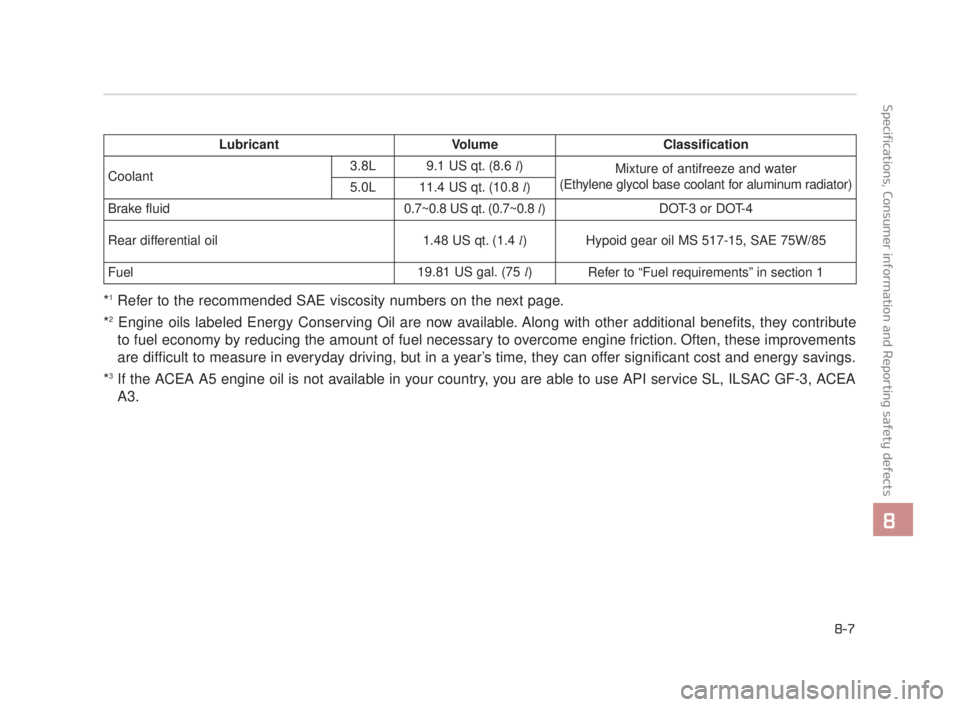
Specifications, Consumer information and Reporting safety defects
8
8-7
*1Refer to the recommended SAE viscosity numbers on the next page.
*
2Engine oils labeled Energy Conserving Oil are now available. Along with other additional benefits, they contribute
to fuel economy by reducing the amount of fuel necessary to overcome engine friction. Often, these improvements
are difficult to measure in everyday driving, but in a year’s time, they can offer significant cost and energy savings.
*
3If the ACEA A5 engine oil is not available in your country, you are able to use API service SL, ILSAC GF-3, ACEA
A3.
LubricantVolumeClassification
Coolant 3.8L9.1 US qt. (8.6 l)Mixture of antifreeze and water
(Ethylene glycol base coolant for aluminum radiator)
5.0L11.4 US qt. (10.8 l)
Brake fluid0.7~0.8 US qt. (0.7~0.8 l)DOT-3 or DOT-4
Rear differential oil1.48 US qt. (1.4 l)Hypoid gear oil MS 517-15, SAE 75W/85
Fuel19.81 US gal. (75 l)Refer to “Fuel requirements” in section 1
KH USA 8:2018 4/14/2017 6:44 PM Page 7
Page 524 of 544

8-8
Specifications, Consumer information and Reporting safety defects
Recommended SAE viscosity
number
Engine oil viscosity (thickness) has
an effect on fuel economy and cold
weather operating (engine start and
engine oil flowability). Lower viscosi-
ty engine oils can provide better fuel
economy and cold weather perform-
ance, however, higher viscosity
engine oils are required for satisfac-
tory lubrication in hot weather. Using
oils of any viscosity other than those
recommended could result in engine
damage. When choosing an oil, consider the
range of temperature your vehicle
will be operated in before the next oil
change.
Proceed to select the recommended
oil viscosity from the chart.
Temperature Range for SAE Viscosity Numbers
Temperature
Engine Oil *
1
°C
(°F)-30 -20 -10 0 10 20 30 40 50 -10 0 20 40 60 80 100 120
10W-30
5W-30
Temperature Range for SAE Viscosity Numbers
Temperature
Engine Oil *
1
°C
(°F)-30 -20 -10 0 10 20 30 40 50 -10 0 20 40 60 80 100 120
1. An engine oil displaying this API Certification Mark conforms to the
international Lubricant Specification Advisory Committee (ILSAC). It
is recommended to only use engine oils that uphold this API
Certification Mark.
10W-30
5W-20, 5W-30
■3.8L
■ 5.0L
KH USA 8:2018 4/14/2017 6:44 PM Page 8
Page 536 of 544
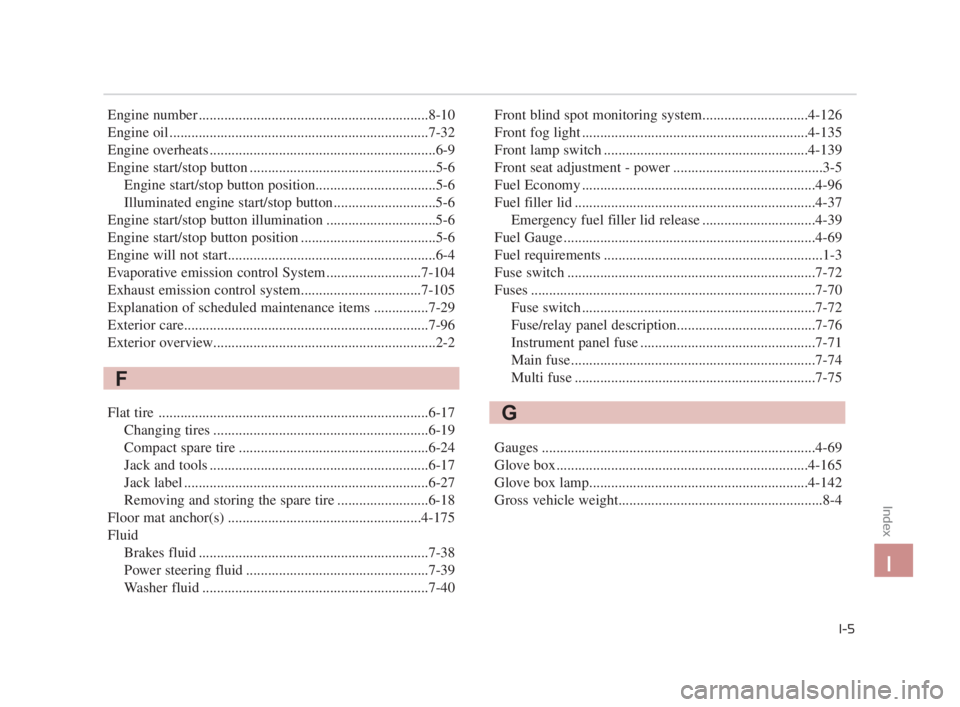
Engine number ...............................................................8-10
Engine oil .......................................................................7\
-32
Engine overheats ..............................................................6-9
Engine start/stop button ...................................................5-6Engine start/stop button position.................................5-6
Illuminated engine start/stop button............................5-6
Engine start/stop button illumination ..............................5-6
Engine start/stop button position .....................................5-6
Engine will not start.........................................................6-4
Evaporative emission control System ..........................7-104
Exhaust emission control system.................................7-105
Explanation of scheduled maintenance items ...............7-29
Exterior care...................................................................7-96
Exterior overview.............................................................2-2
Flat tire ........................................................................\
..6-17 Changing tires ...........................................................6-19
Compact spare tire ....................................................6-24
Jack and tools ............................................................6-17
Jack label ...................................................................6-27
Removing and storing the spare tire .........................6-18
Floor mat anchor(s) .....................................................4-175
Fluid Brakes fluid ...............................................................7-38
Power steering fluid ..................................................7-39
Washer fluid ..............................................................7-40 Front blind spot monitoring system.............................4-126
Front fog light ..............................................................4-135
Front lamp switch ........................................................4-139
Front seat adjustment - power .........................................3-5
Fuel Economy ................................................................4-96
Fuel filler lid ..................................................................4-37
Emergency fuel filler lid release ...............................4-39
Fuel Gauge .....................................................................4-6\
9
Fuel requirements ............................................................1-3
Fuse switch ....................................................................7-72\
Fuses ........................................................................\
......7-70 Fuse switch ................................................................7-72
Fuse/relay panel description......................................7-76
Instrument panel fuse ................................................7-71
Main fuse...................................................................7-74
Multi fuse ..................................................................7-75
Gauges ........................................................................\
...4-69
Glove box.....................................................................4-1\
65
Glove box lamp............................................................4-142
Gross vehicle weight........................................................8-4\
Index
I-5
I
F
G
KH USA Index:2018 4/18/2017 10:39 AM Page 5
Page 539 of 544
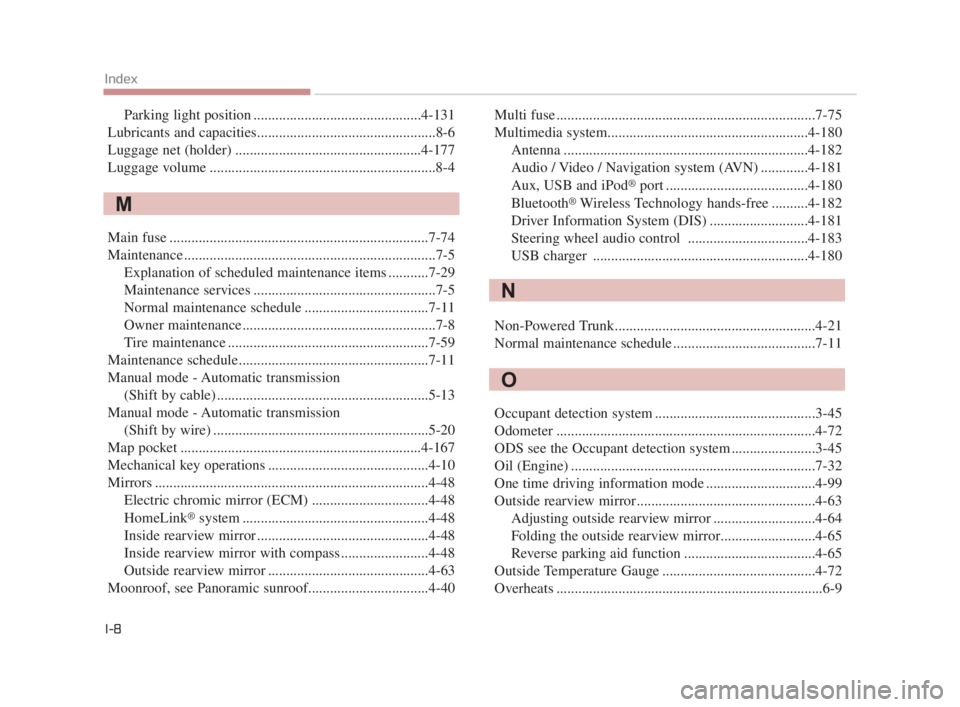
I-8
Index
Parking light position ..............................................4-131
Lubricants and capacities.................................................8-6
Luggage net (holder) ...................................................4-177
Luggage volume ..............................................................8-4
Main fuse .......................................................................7\
-74
Maintenance .....................................................................7-5\
Explanation of scheduled maintenance items ...........7-29
Maintenance services ..................................................7-5
Normal maintenance schedule ..................................7-11
Owner maintenance.....................................................7-8
Tire maintenance .......................................................7-59
Maintenance schedule....................................................7-11
Manual mode - Automatic transmission (Shift by cable) ..........................................................5-13
Manual mode - Automatic transmission (Shift by wire) ...........................................................5-20
Map pocket ..................................................................4-167
Mechanical key operations ............................................4-10
Mirrors ........................................................................\
...4-48 Electric chromic mirror (ECM) ................................4-48
HomeLink
®system ...................................................4-48
Inside rearview mirror ...............................................4-48
Inside rearview mirror with compass ........................4-48
Outside rearview mirror ............................................4-63
Moonroof, see Panoramic sunroof.................................4-40 Multi fuse .......................................................................7\
-75
Multimedia system.......................................................4-180
Antenna ...................................................................4-182\
Audio / Video / Navigation system (AVN) .............4-181
Aux, USB and iPod
®port .......................................4-180
Bluetooth®Wireless Technology hands-free ..........4-182
Driver Information System (DIS) ...........................4-181
Steering wheel audio control .................................4-183
USB charger ...........................................................4-180
Non-Powered Trunk.......................................................4-21
Normal maintenance schedule .......................................7-11
Occupant detection system ............................................3-45
Odometer .......................................................................4\
-72
ODS see the Occupant detection system .......................3-45
Oil (Engine) ...................................................................7-32
One time driving information mode ..............................4-99
Outside rearview mirror.................................................4-63 Adjusting outside rearview mirror ............................4-64
Folding the outside rearview mirror..........................4-65
Reverse parking aid function ....................................4-65
Outside Temperature Gauge ..........................................4-72
Overheats ........................................................................\
.6-9M
N
O
KH USA Index:2018 4/18/2017 10:39 AM Page 8